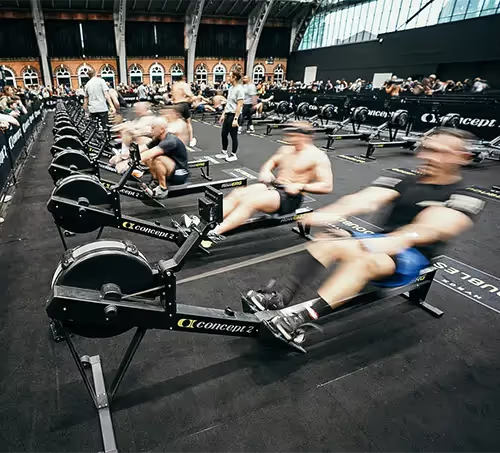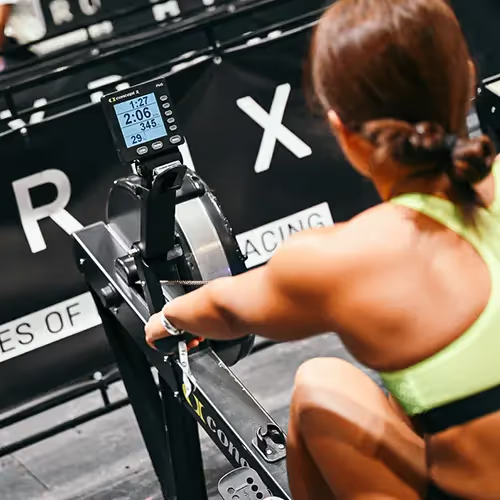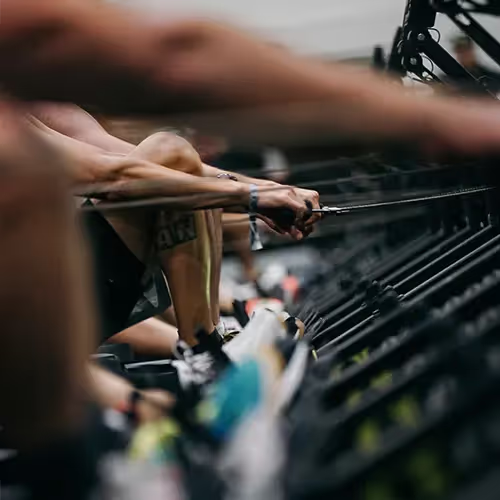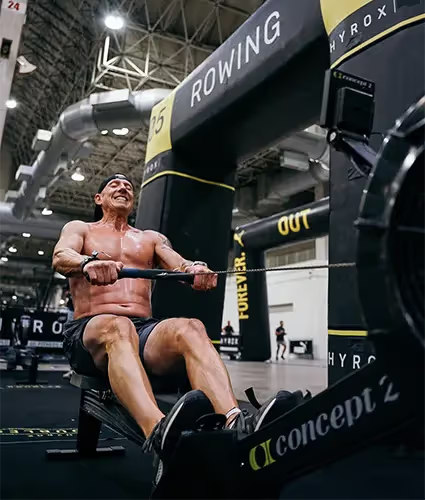HYROX Rowing station
Discover expert tips, training plans, and insights on HYROX rowing to boost your performance and achieve your fitness goals today!



Discover expert tips, training plans, and insights on HYROX rowing to boost your performance and achieve your fitness goals today!


Signed up or thinking of signing up for a HYROX race?
Are you a hybrid athlete looking to improve your technique, speed and efficiency on the rower?
You’re in the right place!
In this article we’ll be covering all the facts and information you need to know about the rowing station at a HYROX event as well as giving you tips to improve your performance and implement rowing in your training more effectively when preparing for a race.
You’ll face up with the Concept2 row-erg in the fifth station at a HYROX race.
By the time you get to rowing you’ll have 5kms of running under your feet and lots of pushing, pulling and jumping behind you as well.
Meaning if you think you’ll be grabbing that handle and pulling like you’d do in a normal training session you may find yourself sorely mistaken.
Rowing in a HYROX race both requires lung capacity as well as muscular endurance and mental toughness.
But before we discuss how you can arrive to this station prepared let’s have a look at the technical facts.

EVERY division has to complete 1000m of rowing to move on from the station.
Even all three doubles categories will have to complete exactly 1000m.
Average times and top time ranges for each division:
Men 4:50 - Top times 3:45/4:00
Women 5:05 - Top times 4:15/4:30
Men’s pro 4:30 - Top times 3:45/4:00
Women’s pro 4:55 - Top times 4:10/4:30
*Men’s doubles 4:20
*Women’s doubles 5:10
*Mixed doubles 4:35
You’ll note that PRO and non-PRO top times fall in the same ranges. This is possibly due to highly technical or proficient rowers outperforming their own average across the rest of the race.
*In the Doubles category we found too much inconsistency with top logged scores on the official HYROX website to confidently report a range for top scores.
HYROX utilizes Concept2 rowers, these pieces of machinery are the most reliable rowers on the market.
If you train at a globo gym you might find they do not carry Concept2 rowers but if you have access to a CrossFit or functional fitness gym you can rest assured you’ll find multiple ones there.
If you have no options to access a Concept2 erg other row ergs will do the trick. But be prepared to find yourself rowing longer than expected on race day as each machinery has their own algorithm to calculate total rowed distance and speed.

We find foot straps are generally up to personal preference and something you can play around with during training to find what works best for you.
However, if you are looking to shave off seconds from your time on race day you may find sizing up on the number you use for your foot straps will allow you to quickly slip in and out of the foot holds.
When it comes to the damper things aren’t as simple. It arguably is the most technical component to sort out when rowing (and setting up your rower). For optimal results we recommend reading this article where we discuss the purpose of the damper and how to find the optimal set up for you. Or check out the video below.
" frameborder="0" allow="autoplay; fullscreen; picture-in-picture" allowfullscreen>
On race day you’ll likely find a rower with a slightly different resistance than the one you’re used to training with as use, age and dust accumulation of the erg’s fan affect the resistance in the pull and therefore where optimal damper placement will be. Don’t let this discourage you! For 1000m the difference won’t be so crucial and you will still be best off placing the damper within the same range you usually utilize in your day to day training.
When looking at the Concept2 display there are a few sections and metrics you should familiarize yourself with to improve the quality of your training.
First let’s talk “Home Screen”. It’s the first screen that shows up when you click on any button of the display, and it will showcase a series of options.
At the top you’ll find “Just row” which is the entry you’ll likely use the most often. Actually if you just start rowing without touching any button on the display it will automatically turn on “Just row”.

Another option you may want to familiarize yourself with is the voice just below “Just row” and that is “Select workout”. Here you’ll usually want to set yourself up through “New Workout”. This can be particularly hand if you are rowing distance repeats or intervals or are completing a test trial. In “New Workout” you can input the details of your session and at completion it will show you a recap of times and stats.
Once you have your display set up for your workout you’ll have to choose what unit you’ll be wanting to use. Given that in HYROX training you’ll most likely be working with set distances to complete or time intervals we find the most useful units to use are distance (in meters) and split time.
To adjust your display to your desired metric press on the “Unit” button until you have selected the meters option, or alternatively the average split time for 500m (speed).
You can also play around with the “Display” button to find your preferred option for how the metrics are showcased on the display.
Rowing is as much about your fitness and conditioning as it is about technique. Technically efficient athletes can row much faster at a fraction of the effort so it’s in your best interest to study up on proper technique.
We have several videos on our YouTube channel about correct rowing form, how to achieve optimal body positioning and fixing common mistakes.
This is the latest:
" frameborder="0" allow="autoplay; fullscreen; picture-in-picture" allowfullscreen>
We recommend giving it a watch before continuing with this article as it will make understanding the next sections and applying corrections much easier.
Once you’ve gotten proper form down the next thing to look at is how you start each rowing effort. This is because when you begin rowing the flywheel needs to ramp up to your pace by gradually introducing air into the wheel box. To speed up this process you’ll notice most rowers use a very specific technique.
After the initial pull they'll complete a series of shorter pulls first with just their arms and then gradually involving legs and back more. This allows a higher frequency turnover on the flywheel bringing in air much faster, in turn you’ll see your speed split go up equally as quickly on the Concept 2 screen meaning you are getting more “meter” bang for your “effort” buck.
The best way to train rowing when doing hybrid fitness or preparing for a HYROX race is to start by building your endurance base, move onto ramping up intensity and as you get closer to race day transition to mixed modality, circuit training where rowing is combined with multiple other exercises from the other stations, as well as running.
What’s great about starting off by building your endurance base is that this will also help you running, especially if your aerobic capacity is pretty low.
And it’s even more crucial if you are relatively new to running. This is because spending more time on the rower will improve conditioning across all activities.
Meaning you will get better at running without having to constantly train it.
Why is this important?
Rowing is much less taxing on your joints than running is, so especially for people who don’t come from a running background it will allow you to keep on progressing without risking injury or hindering your progress from straining your joints too much.
Excited to get to work but not sure what next steps to take?
If you want to enjoy your training without stressing about what to do each workout check out our official HYROX training plan.

With a movement requiring a high oxygen intake like rowing, especially when you’re already coming from a high fatigue situation like in the case of HYROX it’s far too easy to lose control of your breathing.
But there’s no bigger mistake you can commit.
Controlled, properly timed breathing is essential to perform your best on the rower.
This is how to breathe on the rower based on the level of exertion:
If you are rowing at a Zone 2 pace (easy and comfortable) we recommend nasal breathing, breathing out on the pull (=as you go backwards) and breathing in on the release as you bend your legs, straighten your arms and return closer to the display.
Important NOTE: nasal breathing helps control heart rate so if you are reaching the rower after an intense effort utilizing nasal breathing can help bring heart rate down to a more manageable range before your next outburst.
If you are rowing at a moderate effort you may find it better to switch to nasal breathing on the inhale and exhaling through the mouth.
Lastly as intensity gets higher there are two switches you can implement. First try breathing in and out on both the pull and the release. Essentially taking two breaths for every row you complete. This can be done as nasal breathing, mixed or, as your final option, you can adopt mouth breathing. But we recommend mouth breathing only for really intense efforts.
We mentioned in the “What you need to know” section that how you adjust your foot straps can make transitioning on and off the rower much faster.
This is particularly true for training and CrossFit competitions.
However during a HYROX race there are a few things to keep in mind.
Most importantly you don’t get to adjust your rower beforehand so what you need is to become really good at achieving a decent set up really fast. Even better if you can do so while already rowing.
Here are our best tips:
When our athletes approach the rowing station at a HYROX race we leave them with a couple of reminders and pacing tips.

If you are preparing for a HYROX race and don’t have access to a rowing machine this section is for you.
The first thing to discuss is what options do you have to gain access to a rower? Because the truth is there is nothing quite like the real deal. So even if it’s on a once-a-week basis accessing a rower for a single training session can do leaps and bounds to help. If you can bring up that frequency even more that would be awesome. And if you’re unsure WHERE to find a rower we recommend taking a look at functional fitness gyms close to you as those will be your safest bet.
Now, let’s discuss substitutions.